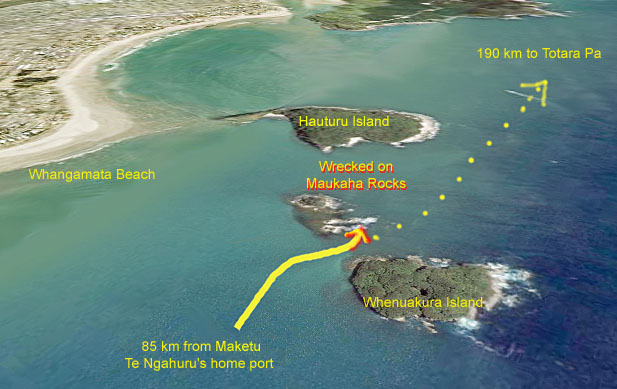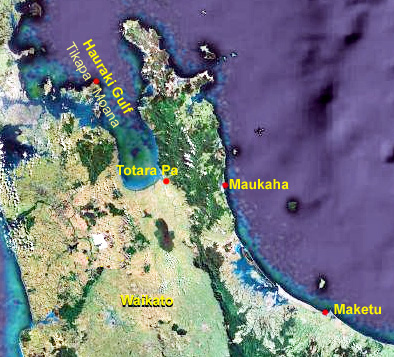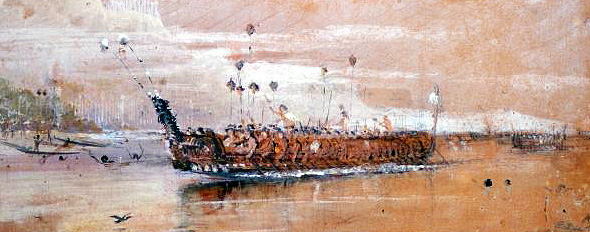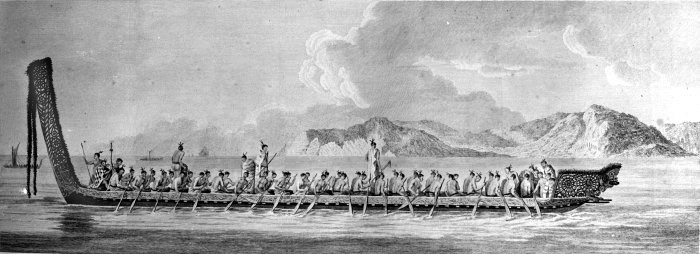E
muri ahiahi,
ka totoko te aroha,
Wairua o te hanga,
ka wehe i a au.
Wai te teretere,
e rere i waho ra?
Nou na e Te Kou,
e hoki koutou,
Ripa ki te whenua,
ki Maketu ra ia.
Tenei matou
kei runga i te toka.
Me rauhi noa,
ki te wairua kau;
Te waka ra e,
i tataia mai,
Toroa i te wai,
kia paia atu koe,
Haere ki raro ra,
ki Hauraki raia
Hei matakitaki ma te nui
a 'Ti-Maru.
Nei, ka pae noa,
ki Maukaha ra ia! |
As
darkness falls,
Sadness comes to my mind,
haunted by the crafted thing
taken from me.
Whose is that group of travellers
sailing by over there?
Ah, it's yours, Te
Kou-a-Rehua.
You're on your way back
horizonwards to the land
at Maketu far away,
while we're here
on top of this rock.
To cheer myself up,
I focus on the memory
of how the craft used
to be;
lashed tight, bailed out, all in order,*
an albatross of the
sea
you were not yet obstructed
from going on
our trip
north,
all the way to Hauraki,
to be admired by the crowds
of Ngati Marutuahu.
But now, we're
totally
wrecked
back here at Maukaha Rock! |
*
Tātaia,
to be set in order
Tātāia,
to be knocked repeatedly, lashed together.
Tatāia,
to be bailed out.
The wreck of Te Whakapū
In
about 1790, the young Tuhoe chief Te Ngahuru
refurbished the beautifully carved old "Te Whakapu"
war canoe and set out from Maketu with some 40 of
his men to paddle it north to Tauranga, Whangamata,
Whitianga, around the Coromandel peninsular into the
Hauraki Gulf and back home again, a round trip of
nearly 600 km.
But
they only paddled it as far as Whangamata. As they
tried to leave the shelter of Whenuakura Island, his
crew could not manoeuvre the long vessel precisely
enough in the rough waters, and it was swept onto
the rocks behind the island instead, unnoticed by Te
Kou-a-Rehu, a high chief of Ngati Pukenga at
Tauranga.

Paddling
around Maukaha
Grant
McIntosh of Whangamata, a descendant of Te
Ngahuru, writes,
"The
rocks are rounded and a quite deceptive.
Many of them are underwater, and their
position between two islands creates unusual
wave focus and currents. They are
plentiful in kaimoana. An elder Laura
Hiku of Ngati Hako told me once that the rocks
are tapu. I wonder if this is because of that
event."
And
a kayaker in the 2005 Coromandel 12-hour
Adventure Race describes the waters Te Ngahuru
tried to paddle through 200 years previously.
 "Coming
out from behind Hauturu Island we headed off
to have a look at Maukaha, but there were a
lot of dangerous looking rocks and
water around here, so we headed on do a
circuit of Whenuakura Island. "Coming
out from behind Hauturu Island we headed off
to have a look at Maukaha, but there were a
lot of dangerous looking rocks and
water around here, so we headed on do a
circuit of Whenuakura Island.
"There
were a lot of boats attempting to land on
Whenuakura, and people seemed to be doing OK
despite the 3 metre swell that was
rolling through the narrow gaps.
"The
tide had started going out a few
minutes before we started the race, and with
the swell rolling in, and the narrow
harbour mouth, there was a lot of cross
current and reflected wave action
going on, which made for very interesting
paddling!"
Te
Ngahuru 
Te
Ngahuru was born sometime around 1770 and died
in about 1823. In the early 19th century, he
was one of the greatest warriors of the
Ruatoki district and was famed for his skill
with the taiaha. One historian p.25
gives a graphic account of his heroic death at
Maketu by a war-party from Waikato, but his
official biographer says he died of influenza.
DNZB
Mihi-ki-te-kapua
Although
this song has been attributed to Te Ngahuru, it
has all the hallmarks of Tuhoe composer
Mihi-ki-te-kapua. She was noted for expressing
yearnings arising from feelings of deep
loneliness, for selecting her words precisely,
and for arranging the lines of a song skillfully
to build up the exposition of ideas, just as in
this moteatea. DNZB
See
these other later songs of hers.
Taku Rakau E
Engari Te Titi
Te
Kou
Te
Kou-a-Rehua was a high chief of the Ngati
Pukenga sub-tribe of Tauranga. During Hongi's
wars in the 1820s his tribe moved to the
Coromandel Peninsula where they were gifted
lands by the Ngati Maru to thanks them for their
assistance in battle. Te Kou-o-Rehua signed the
Treaty of Waitangi in 1840.
Sources
Because
of its beautifully crafted sonnet-like
structure, and Te Ngahuru's fame as a warrior,
this moteatea became widely known, and was
recorded in print many times.
1849
by W.B. Baker of Wanganui, The
New Zealander
1853 by Sir George Grey, Ko
Nga Moteatea
1855 by Rev Richard Taylor, Te
Ika a Maui
1861 by William Bailey Baker, On
Popular Maori Poetry
1888 by John White, The
Ancient History of the Maori
1898 by John Mcgregor, Popular
Maori Songs
1929 by Sir Apirana Ngata, Nga
Moteatea
A
Ngati Maru version
A
modification of this song by the Ngati Maru
from Hauraki was recently quoted in a Treaty
of Waitangi document. PDF
|
E
muri ahiahi
ka totoko te aroha
Wairua o te hanga
ka wehe i ahau.
Wai te teretere
e rere i waho ra?
Nou e te iwi Hauraki!
E hoki koutou
Ripa ki te whenua
ki Te Totara ra ia
Tenei matou
kei runga i te toka.
Me rauhi mai
te wairua kau
Te waka ra e
i tataia mai
Toroa i te wai
kia paia atu koe
Haere ki raro ra
ki Hauraki ra ia
Hei matakitaki mai
m? 'ati Maru
Nei ka pae noa
ki Tikapa Moana
2
|
|
As
darkness falls,
I'm filled with sadness,
haunted by the crafted thing
that I've lost.
Whose contingent is that
sailing by over there?
Ah,
it's yours, Hauraki people.
You're on your way back
heading for home,
right back to Te Totara pa,
while we're
here
on top of this rock.
To cheer myself up,
I focus on the memory
of how
the craft used to be,
you were all
dried out,
an
albatross of the sea,
you were not yet blocked
from going way down,
all the way to Hauraki,
to be looked upon with envy
by the Ngati
Maru.
Now it's totally wrecked here
in the Hauraki Gulf
|
2.
'Ki Tikapa Moana'.
This
may have originally been 'Ki
Tikapa raia' = At
Gannet Rock itself. Tikapa,
or Gannet Rock, is on the north-east
point of Waikeke Island, in the
middle of the Hauraki Gulf.
The
war canoes of Ngati Maru
|
The
Ngati Marutuahu, from Te Totara Pa
(now the town of Thames), were
famous for their big sea-going war
canoes made from giant kauri trees
that grew in the area.
The Otunui and the Otuiti
had hulls some 2.5m across, with
side-strakes about 50cm high. Five
warriors could sit at each bench
seat, allowing alternate teams to
paddle, bail or rest.
The
broader beam and extra crew
enabled these waka taua to
navigate the rougher offshore
waters, well away from rocks.
But
most other war canoes had a hull
carved from a tree-trunk only
about 1.3m wide. These vessels
were well suited for rivers and
lakes but on coastal journeys they
were easily flooded in rough seas.
So they had to stay close inshore
where the waters were sheltered.
And where there were lots of
rocks!
It
seems that a Ngapuhi war canoe had
gone on the rocks in the gulf,
perhaps off the nor-east tip of
Waiheke Island, early in the 19th
century. The stranded Ngapuhi
warriors had watched helplessly as
a victorious Ngati Maru war fleet
returned from a raid on one of
their settlements,
|
Hongi
Hika's War
But
the Ngati Maru had killed a relative
of Hongi Hika during one of these
raids. He was in Sydney helping
missionaries write a Maori
dictionary, and he vowed revenge.
He obtained 300 muskets, returned to
the Bay of Islands and took a fleet
of war canoes first to the East
Coast, and then south to Te Totara
pa where he killed all its
defenders.
He
followed this up with attacks on
other tribes, starting a desperate
effort by tribes everywhere to get
muskets of their own.
One musket could be acquired for
three tons of flax fibre. So
they produced thousands of tons of
scraped flax (used by Europeans for
sail manufacture).
The
Muskets of Hongi.
|

Hongi Hika
returning from the East Coast with trophy
heads in 1819
|



 "Coming
out from behind Hauturu Island we headed off
to have a look at Maukaha, but there were a
lot of dangerous looking rocks and
water around here, so we headed on do a
circuit of Whenuakura Island.
"Coming
out from behind Hauturu Island we headed off
to have a look at Maukaha, but there were a
lot of dangerous looking rocks and
water around here, so we headed on do a
circuit of Whenuakura Island.